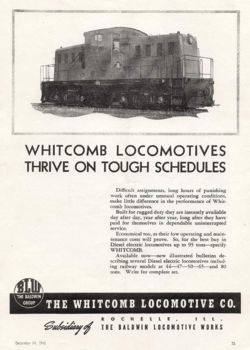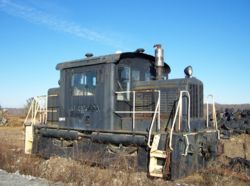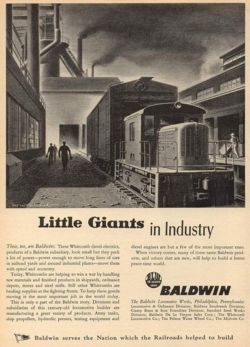Whitcomb Locomotive Works
George Dexter Whitcomb (1834-1914), of Chicago, Illinois, started a modest machine shop in 1878, and began the manufacture of coal mining machinery, laying the foundation for the concern that became known as The Whitcomb Locomotive Company. Mr. Whitcomb designed and marketed the first successful coal mining machine. In 1892, this firm, then located at Orleans and Ohio Streets in Chicago, Illinois was incorporated under the laws of Illinois as George D. Whitcomb Company. This industrialist, inventor and family man also founded Glendora, California, in 1887. Glendora is a suburb of Los Angeles, California.
Mules had long been used exclusively as the motive power in moving coal from the mines, but this method was expensive and unsatisfactory. Because of the insistent demand for a more economical method, experiments were conducted using for power—electricity, compressed air and rope drive. Gasoline engines were definitely a novelty in those early days, nevertheless Whitcomb decided the principle could be successfully applied to a small mine locomotive. In April, 1906 the first successful gasoline locomotive was built and installed in a large Central Illinois coal mine.
The year 1907 saw the company move to Rochelle, in Northern Illinois, where it continued to build quantities of gasoline powered locomotives for mine operation, both coal and metal. The reputation of the Whitcomb gasoline locomotive spread at such a rapid rate that, before long, greater production facilities were needed and in 1912 the plant was again moved to enlarged facilities elsewhere in Rochelle.
World War I saw the output of the Whitcomb plant almost entirely devoted to government orders. Hundreds of armor-plated locomotives were built for overseas service in France. These small 6-ton and 9-ton, narrow gauge locomotives proved highly efficient in trench warfare and they were used extensively in hauling needed supplies up to the front lines. In appreciation of their excellent contributions to the war effort, the Whitcomb Company was awarded a "Certificate of Merit" by the War Department.

Many new innovations in the locomotive field were being introduced during this period. The first explosion-proof electric mine locomotive was designed and built by Whitcomb in 1914 and after exhaustive tests the U. S. Bureau of Mines issued its “Permissibility Plate.” Whitcomb was the first builder of locomotives for underground work to receive such an endorsement. The first Whitcomb electric trolley locomotive was produced in 1921, and in 1929 Whitcomb designed and built the largest gasoline-electric locomotive that had then been offered our American railroads. This development was closely followed by the diesel-electrics which revolutionized the American transportation system.
In 1929 the company was purchased by The Baldwin Locomotive Works, and the new owners, under George Houston sought a greater base of diversified holdings. From 1931 until 1940 the company was operated as the Whitcomb Locomotive Works, a subsidiary of The Baldwin Locomotive Works. During 1940, Baldwin completely took over the company and after that time it was operated as a division of Baldwin known as The Whitcomb Locomotive Company. On July 19, 1932 Whitcomb Locomotive Company acquired the Milwaukee Locomotive Manufacturing Company.
Whitcomb continued to expand and progress after the war and the increased volume of business made it essential to expand storage and shipping facilities. A warehouse complete with the latest in material handling equipment was erected in 1947. A ten-ton overhead yard crane was installed to facilitate handling and storage of steel slabs and sheets. During 1948, a combination loading dock and locomotive test building was erected.

In February of 1952 locomotive production was shifted from Rochelle, Illinois to Baldwin’s Eddystone, Pennsylvania Works. Industrial locomotives continued to be built under the Whitcomb name at Eddystone through the end of December 1952, when the name was dropped. Any Whitcomb locomotives built after that time carried the B-L-H identification.
The last Whitcomb locomotive manufactured at Rochelle was shipped on January 4, 1952 (construction number 61189). It was a 25-ton diesel-electric locomotive delivered to the Central Procurement Agency of the Transportation Corps. This locomotive was lettered and numbered USN No. 65-00330. Production of the Whitcomb locomotive line came to an end in March, 1956. Whitcomb was a large manufacturer of train locomotives in Rochelle and built around 5,000 units. The company also manufactured an automobile known as the Partin and Palmer. A restored model is now displayed in the Flagg Township Historical Museum, in Rochelle.

